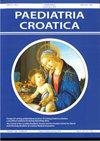桡骨纵向缺损和拇指发育不全的分期重建——病例报告和文献复习
Q4 Medicine
引用次数: 0
摘要
目的:介绍一名IV型桡骨纵向缺损和IV型拇指发育不全女孩的手术治疗,并回顾过去25年发表的最相关文献。方法:治疗包括放置外固定器,随后在桡尺轴和近远轴进行牵张,作为初始手术,然后在2岁左右,即初始手术后10周,根据Buck Gramcko进行放射治疗。治疗的最后一步是在4岁生日前对食指进行花粉化。结果:手术治疗取得了非常有利的结果——临床上稳定的手腕,尺骨上的腕关节在放射学上排列良好,食指可以充分对抗其他手指。结论:对过去25年的文献综述表明,尺骨放射治疗加先前的分心比单纯集中治疗有好处。手腕的牵张保护了尺骨远端生长板,从而促进了生长。用双叶皮瓣松解软组织也可以提供良好的结果,以及从第二趾转移微血管关节,而后者需要先进的显微外科技术。本文章由计算机程序翻译,如有差异,请以英文原文为准。
Staged reconstruction of radial longitudinal deficiency and thumb aplasia – case report and a review of the literature
Purpose: Presentation of surgical treatment of a girl with type IV radial longitudinal deficiency and type IV thumb hypoplasia as well as review of the most relevant literature published in the previous 25 years. Methods: The treatment consisted of placement of an external fixator and subsequent distraction in the radioulnar and proximodistal axis as the initial procedure followed by radialization according to Buck-Gramcko around the 2nd birthday, 10 weeks after the primary procedure. The last step of the treatment was a pollicization of the index finger performed before the 4th birthday. Results: The surgical treatment resulted with a very favorable outcome – a clinically stable wrist, radiologically well aligned carpus over the ulna and an index pollicised in such a manner that enables adequate opposition to the other fingers. Conclusion: A review of literature in the last 25 years shows that radialization of the ulna with a preceding distraction offers benefits over centralization alone. Distraction of the wrist protects the distal ulnar growth plate and thus promotes growth. Soft tissue release with a bilobar flap can also provide a good outcome as wells as a microvascular joint transfer from the 2nd toe whereas the latter requires advanced microsurgical skills.
求助全文
通过发布文献求助,成功后即可免费获取论文全文。
去求助
来源期刊

Paediatria Croatica
医学-小儿科
CiteScore
0.20
自引率
0.00%
发文量
0
审稿时长
6-12 weeks
期刊介绍:
In the inaugural 1956 issue of the journal, the editor Dr Feđa Fischer Sartorius outlined the journal''s vision and objectives saying that the journal will publish original papers on the development, pathology, and health care of children from the prenatal period to their final biological, emotional and social maturity. The journal continues this vision by publishing original research articles, clinical and laboratory observations, case reports and reviews of medical progress in pediatrics and child health.
 求助内容:
求助内容: 应助结果提醒方式:
应助结果提醒方式:


